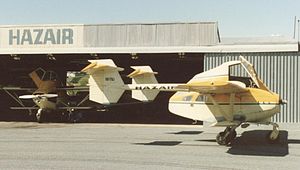Transavia PL-12 Airtruk
| PL-12 Airtruk | |
|---|---|
 |
|
| PL-12 Airtruks of Hazair at Albury airport, New South Wales, in March 1988 | |
| Role | Agricultural aircraft |
| National origin | Australia |
| Manufacturer | Transavia Corporation |
| Designer | Luigi Pellarini |
| First flight | 22 April 1965 |
| Produced | 1966-1993 |
| Number built | 118 |
| Developed from | Bennett Airtruck |
The Transavia PL-12 Airtruk is a single-engine agricultural aircraft designed and built by the Transavia Corporation in Australia. The Airtruk is a shoulder-wing strut braced sesquiplane of all-metal construction, with the cockpit mounted above a tractor-location opposed-cylinder air-cooled engine and short pod fuselage with rear door. The engine cowling, rear fuselage and top decking are of fibreglass. It has a tricycle undercarriage, the main units of which are carried on the lower sesquiplane wings. It has twin tail booms with two unconnected tails. Its first flight was on 22 April 1965, and was certified on 10 February 1966.
It was developed from the Bennett Airtruck designed in New Zealand by Luigi Pellarini. It has a 1 metric ton capacity hopper and is able to ferry two passengers as a topdresser. Other versions can be used as cargo, ambulance or aerial survey aircraft, and carry one passenger in the top deck and four in the lower deck.
The Airtruk is also sometimes known as the Airtruck. Because the name "Airtruck" was registered by the New Zealand companies Bennett Aviation Ltd and Waitomo Aircraft Ltd, for their PL-11, Transavia found another name for their PL-12 ("Airtruk").
July 1978 saw the first flight of an improved model, the T-300 Skyfarmer, which was powered by a Textron Lycoming IO-540-engine. This was followed in 1981 by the T-300A with improved aerodynamics. Transavia ceased production of the T-300 in 1985.
In 1982 certification was undertaken to enable sales in the North American market. Assistance was provided by the Aeronautical Research Laboratories (ARL) of the Defence Science and Technology Organisation (DSTO) and extensive tests carried out on the ground and in subsequent flight flutter clearance trials. ref. DSTO Structures Tech. Memo. 341
In 1985 an extended version was produced and released as the T-400. The engine was changed from a 6-cylinder to an 8-cylinder and the tail booms extended by 750 millimetres. Other minor changes were made to the aerodynamics. Flutter clearance tests were again carried out by ARL and manufacture proceeded.
...
Wikipedia
